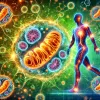Welcome back to our regular feature where we sift through thousands of new, health-related papers, and pick a few to summarize in a practical and not anxiety-inducing way.
Our main questions on each paper:
- In simple language, what does it say?
- Does it have good evidence?
- Should what it says matter to normal people?
- What simple thing, if anything, could a normal person do to take advantage of this finding?
Okay, away we go. And, as always, we rate each paper for practicality and level of interest.
This edition's articles and papers:
- Effect of exercise for depression: systematic review and network meta-analysis of randomised controlled trials | The BMJ https://www.bmj.com/content/384/bmj-2023-075847
- The anabolic response to protein ingestion during recovery from exercise has no upper limit in magnitude and duration in vivo in humans - ScienceDirect https://www.sciencedirect.com/science/article/pii/S2666379123005402
- Enteric and systemic postprandial lactate shuttle phases and dietary carbohydrate carbon flow in humans | Nature Metabolism https://www.nature.com/articles/s42255-024-00993-1
- Dynamics of nanocluster aerosol in the indoor atmosphere during gas cooking | PNAS Nexus | Oxford Academic https://academic.oup.com/pnasnexus/article/3/2/pgae044/7614671?login=false
- Aerobic, muscle-strengthening, and flexibility physical activity and risks of all-cause and cause-specific mortality: a population-based prospective cohort of Korean adults - PMC https://www.ncbi.nlm.nih.gov/pmc/articles/PMC10268385/
Paper 1: Dancing and Depression
Practicality (4/5): * 🏃♂️🏃♂️🏃♂️🏃♂️🏃♂️
Interest (4/5): * 🏃♂️🏃♂️🏃♂️🏃♂️
Quick Update
We are returning to this paper one more time, mostly because it continues to be passed around and misunderstood. If you recall, the paper's main claim is that exercise can be more effective than drugs when dealing with mild to moderate depression. And that is fine as far as it goes, even if not particularly surprise.
What really got people's attention, however, was the claim that of all the exercise modes the meta-analysis considered the most effective was ... dancing. This tweet, in particular, seems to have lit people on fire:
They buried the lede on this new study. It's not that exercise beats out SSRIs for depression treatment, but that *just* dancing has the largest effect of *any treatment* for depression.
— Erik Hoel (@erikphoel) February 21, 2024
That's kind of beautiful. pic.twitter.com/9EQZXOtk7s
Let's dig back into this. There is a bunch of associated statistical arcana, common for this sort of meta-analysis, but they matter. In particular, we have a measure called Hedges' G, No (number of studies), k (the number of papers), and SUCRA (a likelihood ranking).

While there is a difference in means, and it's significant, there are problems. First, the confidence intervals overlap, implying that both results could be the same, or even reversed. Second, the number of dancing studies identified is tiny, like 5, with a total of 107 participants. Given the overlapping confidence intervals, this isn't a large enough same to give us confidence or statistical power. We simply can't say much at all.
Is it possible that dancing is better aerobic exercise and has a more dramatic impact on all-cause mortality than other activities? I guess, but it seems unlikely, or at the very least, easily confounded.
Paper 2: Protein Effects on Muscle
Practicality (5/5): * 🏃♂️🏃♂️🏃♂️🏃♂️🏃♂️
Interest (4/5): * 🏃♂️🏃♂️🏃♂️🏃♂️
Summary
Eating large amounts of protein after exercising can aid muscle growth more and for longer than previously believed. Researchers found that people who consumed 100 grams of protein experienced longer-lasting muscle-building effects than those who only consumed 25 grams. This study challenges the idea that there's a limit to how much protein the body can use for muscle growth at one time.
What is the paper's main claim?
- The study claims that high protein intake post-exercise results in prolonged muscle protein building.
Are the methods and/or data it uses appropriate and convincing?
- The research used stable isotopes in feeding trials to measure muscle responses, which is a rigorous method to track protein use in the body.
What do we know now that we didn't know before if anything?
- Contrary to past beliefs, our bodies may use large amounts of protein efficiently.
What simple and practical thing could a normal person do knowing this?
- Consume more protein, especially with increasing age and declining muscle
- Stop worrying about consuming too much protein
Paper 3: Human Carbohydrate Processing
Practicality (5/5): * 🏃♂️🏃♂️🏃♂️🏃♂️🏃♂️
Interest (4/5): * 🏃♂️🏃♂️🏃♂️🏃♂️
Summary
The research investigates how the human body deals with sugar taken from food, specifically focusing on the production and movement of lactate, a byproduct of sugar breakdown, in the gut and the rest of the body after eating. Using non-invasive techniques, the team provided evidence of two phases in this process: first in the gut, then throughout the body. Their findings suggest that lactate plays a central role in distributing sugar-derived energy and might have further implications for understanding diabetes treatments like metformin.
What is the paper's main claim?
- The study claims that after eating sugar lactate plays a key role in shuttling energy first from the gut and then systemically throughout the body.
Are the methods and/or data it uses appropriate and convincing?
- Yes, the researchers used a common clinical test with added tracers to track lactate and glucose, providing a concrete look at the process.
What do we know now that we didn't know before if anything?
- This work provides new insight into the timing and significant role of lactate in dispersing sugar energy after a meal, including an initial response from the gut.
What simple and practical thing could a normal person do knowing this?
- For those managing conditions like diabetes, this research underlines the importance of understanding how different parts of the body, including the gut, contribute to sugar and energy regulation.
- For the rest us, it is a reminder that lactate remains less understood that is optimal.
Paper 4: Indoor Cooking Pollution
Practicality (5/5): * 🏃♂️🏃♂️🏃♂️🏃♂️🏃♂️
Interest (4/5): * 🏃♂️🏃♂️🏃♂️🏃♂️
Summary
The research explores how tiny pollutants, specifically nanocluster aerosols (NCA), are produced in significant amounts while cooking with gas indoors. These NCAs can deeply penetrate our respiratory systems and may carry health risks. Due to their small size and large surface area, they behave differently than typical indoor pollutants, and the study finds that regular air quality measures like PM2.5 don't adequately account for their presence.
What is the paper's main claim?
- Tiny, potentially harmful particles are prolific during gas cooktop use in homes, requiring direct measurement due to their unique behavior.
Are the methods and/or data it uses appropriate and convincing?
- The sophisticated tools used successfully identified these tiny indoor air pollutants, which commonly used air quality metrics miss.
What do we know now that we didn't know before if anything?
- Standard indoor air quality measures fail to detect a significant health risk from nanoscale pollutants resulting from gas cooking.
What simple and practical thing could a normal person do knowing this?
- Increase ventilation while cooking with gas to help reduce these tiny but potentially harmful particles from lingering in the air.
- Considering dumping that gas stove.
Paper 5: Stretching and Mortality
Practicality (5/5): * 🏃♂️🏃♂️🏃♂️🏃♂️🏃♂️
Interest (4/5): * 🏃♂️🏃♂️🏃♂️🏃♂️
Summary
This study examines the relationship between different types of physical activities, such as aerobic, muscle-strengthening, and flexibility exercises, and their impact on all-cause and cause-specific mortality in Korean men and women. Findings suggest that all three types of activities are beneficial, with aerobic and flexibility activities particularly associated with a lower risk of death from cardiovascular causes.
What is the paper's main claim?
- The study suggests that regular physical activity, including aerobic, muscle-strengthening, and flexibility exercises, reduces the risk of premature death.
Are the methods and/or data it uses appropriate and convincing?
- Self-reported exercise habits from a large cohort of Korean adults over a significant follow-up period provide convincing evidence of the link between physical activity and longevity.
What do we know now that we didn't know before if anything?
- Flexibility exercises, like stretching and yoga, may also contribute to a reduced risk of death, which has been less studied in past research.
- Some have used this paper to claim that stretching isn't taken seriously enough, but that seems a ... stretch
What simple and practical thing could a normal person do knowing this?
- Integrate a variety of physical activities, including flexibility exercises, into daily life to potentially improve overall health and longevity.
- They key is that, especially starting from nothing, any movement is better than, even if it's just stretching.
We will be back with more papers next week. And if you see a paper that is getting attention, and you wonder if you should care, let us know.





